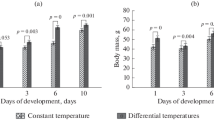Summary
-
1.
The progressive effects of temperature fasting on the blastoderms of chick have been studied.
-
2.
The blastoderms do not show any morphogenetic change up to the 7th day of delay prior to incubation. Embryological changes in form of suppression arise in the organisation of blastoderms delayed over 12 days or more. The axes of the embryos tend to be more shortened in the further delayed embryos.
-
3.
The axial structures of the blastoderms suffer reduction in shape and size until they disappear in the blastoderms kept waiting for 15 to 20 days. The blastoderms enlarge into a sheet-like structure without any mark of organisation.
-
4.
The blastoderms become gradually incapacitated beyond the temperature-fasting for over 20 days.
-
5.
The probable mechanism of these morphogenetic features have been sought in the denaturation of “Cell substances” by dehydration, suppression of mitotic activities and morphogenetic movements of cells of the blastoderms.
Zusammenfassung
-
1.
Es wurden an Hühnerkeimscheiben die Folgen einer zunehmend langen Abkühlung nach der Eiablage untersucht.
-
2.
Bei einem Aufschub der Anbrütung bis zum 7. Tage zeigen die Keimlinge keine Änderungen der Morphogenese. In der Organisation von Keimlingen mit einem Aufschub von 12 und mehr Tagen entstehen Veränderungen der Entwicklung (Unterdrückung). Die länger zurückgehaltenen Embryonen neigen zu einer stärkeren Verkürzung ihrer Achse.
-
3.
Die axialen Strukturen der Keimlinge werden in Gestalt und Ausdehnung reduziert, bis sie bei solchen, die vor der Bebrütung 15–20 Tage zurückgehalten waren, überhaupt fehlen. Die Keimscheiben dehnen sich zu einem flächigen Gebilde aus, das keine Anzeichen von Organisation mehr zeigt.
-
4.
Hat die Abkühlung länger als 20 Tage gedauert, so werden die Keimlinge zunehmend entwicklungsunfähig.
-
5.
Die wahrscheinliche Erklärung für die Entstehung dieser morphogenetischen Merkmale wird in der Denaturierung von „Zellsubstanzen“ durch Wasserverlust, in der Unterdrückung von mitotischer Aktivität und von morphogenetischen Bewegungen der Zellen des Keimlings gesucht.
Similar content being viewed by others
Literatur
Grodzinski, Z.: Über die Entwicklung von unterkühlten Hühnereiern. Arch. Entw.mechan.129, 502–521 (1933).
Hamilton, H. L.Lillies: Development of the chick. 1952.
Pasteels, J.: On the formation of the primary entoderm of the duck (Anas domestica) and on the signification of the bilaminar embryo in birds. Anat. Rec.93, 1–14 (1945).
Mookerjee, S., and A.Bose: Effects of X-radiation on the structural organisation of chick embryos. 1953.
Needham, J.: Biochemistry and Morphogenesis. 1942.
Waddington, C. H.: The epigeneties of birds. 1952.
Author information
Authors and Affiliations
Additional information
C. I. Research Fellow of the National Institute of Science (India).
Rights and permissions
About this article
Cite this article
Mookerjee, S. Effects of temperature-fasting on the structural organisation of chick embryos. W. Roux' Archiv f. Entwicklungsmechanik 146, 537–543 (1953). https://doi.org/10.1007/BF00576581
Received:
Issue Date:
DOI: https://doi.org/10.1007/BF00576581




